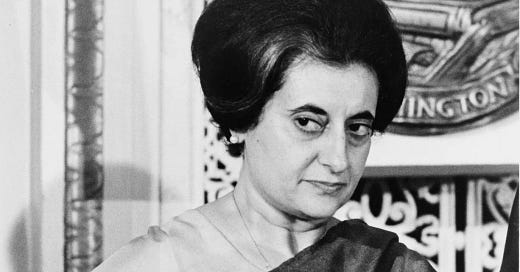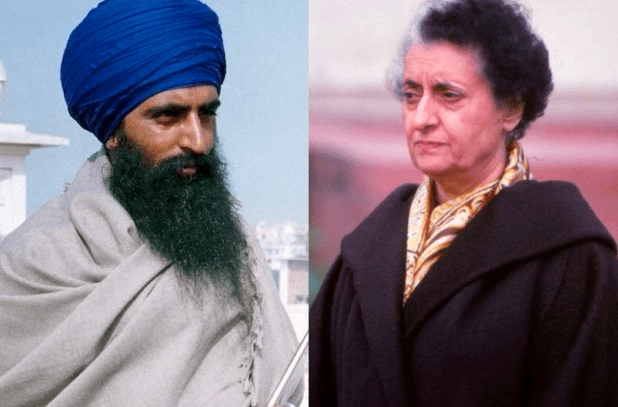Indian Politics 101: The Iron Lady - Part 3
The rise and fall of Indira Gandhi and the implosion of Punjab
The diminutive Indira Gandhi became a giant in India. “India is Indira and Indira is India” rang across Congress rallies to great effect. Indira kicked off her term with the mission of “Garibi Hatao, Desh Bachao” meaning “remove poverty, save the country. Indira decided to double down on India’s socialist streak, which only further worsened India’s economic growth. Sections of the economy would be nationalized and businesses would encounter the dreaded “License Raj,” a bureaucratic nightmare for building businesses or even purchasing mundane things such as phones and televisions. In the midst of this market malaise, however, Indira would lead India in the War of 1971 whereby India avenged partition by splitting Pakistan apart and creating Bangladesh. A resounding victory made Indira iconic. In spite of her popularity with the masses, Indira was found guilty of election fraud in the elections of 1971 conducted prior to the war victory. The judiciary, which was now thoroughly compromised, suspended her membership of Parliament but curiously allowed her to stay on as Prime Minister. Protests erupted from the opposition, and Indira responded by suspending Indian democracy and declaring the Emergency. Indira would curtail many freedoms of Indians as a dictator and persecuted her political enemies. Not just this, she would also change the Indian Constitution, adding the words “Socialist” and “Secular” into the preamble and duly follow it up with conforming policies. After a return to democracy and a prompt election loss to a spirited but shaky coalition, she returned to power again in 1980. This decade would begin one of the most trying periods for the Republic of India.
The charismatic Indira, the superstar of Indian politics, would play too clever by half this round, resulting in a deadly overreach. In a bid to win in Punjab, a border state in India with a majority Sikh population, Indira propped up a religious leader named Jarnail Singh Bhindranwale. Already inspiring and popular, a political tint was combined with his vibrant religious color as the lines between Sikhism and Hinduism, faiths that experienced hundreds of years of syncretism prior, started to bolden. Agitations for special rights for the state of Punjab and a preference for Sikhism over secularism would boil over as Bhindranwale defied his sponsor in Indira and went rogue accusing Indira and the Indian state of preparing to commit atrocities against Sikhs.
Bhindranwale’s most extreme followers would begin a series of murders across Punjab to enforce his vision of Punjab. As the violence spread, the Indian state began to zero in on Bhindranwale and his followers. Bhindranwale eventually took refuge in and militarized Sikhism’s holiest site, the Golden Temple. Indira ordered an attack on the temple itself in 1984, during a Sikh holy day at that, as Sikh regiments of the Indian Army tragically led the charge into the complex damaging the structures and killing both militant and innocent inside. Bhindranwale would die and become a martyr as the attack on the Golden Temple complex only emboldened separatist Sikh elements who wanted to establish “Khalistan,” a theocratic Sikh country in Punjab. Subsequently, Indira Gandhi’s own Sikh bodyguards, incensed at the sacrilege she committed, would assassinate her. The cycle of blood continued as pogroms against Sikhs were then carried out by mobs led by INC leaders. Khalistani terrorists would unleash hellfire across the Punjab particularly aiming their ire and fire at Hindus and heterodox Sikhs. Punjab would burn for nearly a decade thereafter with the rebellion eventually brutally put down by the Indian government.
A grieving India would elect Indira Gandhi’s son, the inexperienced Rajiv Gandhi at a record tally. Yet despite a mammoth mandate, the most important character in this chapter is the opposition. So far, I’ve barely discussed them. That is because for most of India’s history, they were an ineffective motley crew of various ideologies. Early communists gave way to an assortment of socialists, regionalists, and a very small spark of saffron. It is the latter that we will now be looking at. The long shadow of Godse’s assassination was finally beginning to fade.
The Bharatiya Janata Party (BJP) was the offspring of 2 earlier parties. Its saffron father is the Bharatiya Jan Sangh, which was founded in 1951 by ex-Hindu Mahasabha members. Its mixed mother was the Janata Party, founded in 1977 as an amalgam of parties and ideologies opposed to Indira Gandhi’s Emergency. After the Janata Party dissolved in 1980, the BJP was born and started its political journey with a humble 2 seats in 1984. India would now be entering its most chaotic phase of its existence. And it is under this storm of chaos that the party of the lotus would bloom.






